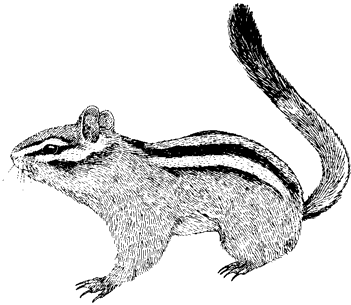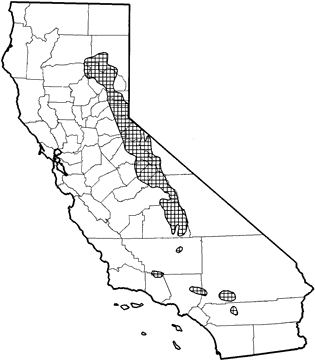
Lodgepole Chipmunk
Distribution, Abundance, and Seasonality
The lodgepole chipmunk is abundant in open-canopy lodgepole pine habitat in the Sierra Nevada from Lassen Co. to Tulare Co. It is less common in closed-canopy forest with sparse undercover. It also occurs in open-canopy stages of other forest habitats including Jeffrey pine, mixed conifer, and red fir. Occupies an elevational range of 1875-3250 m (6000-10,350 ft). In isolated populations in southern California mountains, occurs in open-canopy forests of mixed conifer, Jeffrey pine, lodgepole and limber pine, and occasionally in chaparral. Elevational range in the southern California mountains is 1950-3300 m (6400-10,900 ft).

Range Map
Specific Habitat Requirements
Feeding: Feeds on fungi, seeds of forbs, grasses, shrubs, and trees, berries and other fruits (Tevis 1953, 1955), and some insects. Feeds on the ground, in shrubs, trees, on logs, snags, and stumps. Caches food for winter use.
Cover: Most authors refer to the arboreal habits of this species (Brand 1974, Broadbooks 1974). Uses trees for refuge, observation posts, and nests. Also uses cavities in logs, snags and stumps, and underground burrows.
Reproduction: Uses nests in burrows, and in cavities in trees, logs, stumps, and snags.
Water: No data found.
Pattern: Usually seen close to trees. Prefers open-canopy stages with some shrub cover. More arboreal than other chipmunks, except perhaps T. senex (Sharples 1978).
Species Life History
Activity Patterns: Diurnal. Hibernates. Accumulates fat in autumn, but stored food is the principal energy source for the inactive period. In the Sierra Nevada hibernates from late October or November to March or April. Periods of dormancy are separated by arousals (every 5-6 days). When kept at 4¡C (39¡F), hibernating chipmunks had a body temperature of 4.8-5.2¡C (40.6-41.4¡ F). This species shows a more pronounced inactivity in the laboratory than does T. amoenus or T. minimus (Jameson 1964, Jameson and Mead 1964, Heller and Poulson 1970).
Seasonal Movements / Migration: None.
Home Range: Home ranges of 1.0-2.0 ha (2.5-5.0 ac) were reported by (Roberts 1962).
Territory: Probably defends vicinity of nest. Highly aggressive with other chipmunk species, which it excludes from its preferred habitat.
Reproduction: The single litter is born in June in the Sierra Nevada. Average litter size is 5 (range 3-7) (Verner and Boss 1980). Gestation is about 1 mo.
Niche: This small, diurnal omnivore competitively excludes T. amoenus and T. minimus from lodgepole forests (Heller 1971, Heller and Poulson 1972). However, it is more vulnerable to heat stress, which may preclude it from sagebrush, pinyon-juniper, and alpine habitats (Heller and Gates 1971, Chappell et al. 1978). Predators probably include raptors, weasels, coyotes, foxes, bobcats, and martens. The habit of burying seeds aids in reforestation (Verner and Boss 1980).
Sources & References
California Department of Fish and Game, 1999.
California's Wildlife, Sacramento, CA.
Written by: J. Harris, reviewed by: H. Shellhammer, edited by: R. Duke
Brand, L. R. 1974. Tree nests of California chipmunks. Am. Midl. Nat. 91:489-491. Brand, L. R. 1976. The vocal repertoire of chipmunks (Genus Eutamias) in California. Anim. Behav. 24:319-335. Broadbooks, H. E. 1974. Tree nests of chipmunks with comments on associated behavior and ecology. J. Mammal. 55:630-649. Chappell, M. A. 1978. Behavioral factors in the altitudinal zonation of chipmunks (Eutamias). Ecology 59:565-579. Chappell, M. A., A. V. Calvo, and H. C. Heller. 1978. Hypothalamic thermosensitivity and adaptations for heat-storage behavior in three species of chipmunks (Eutamias) from different thermal environments. J. Comp. Physiol. 125:175-183. Grinnell, J., and T. I. Storer. 1924. Animal Life in the Yosemite. Univ. California Press, Berkeley. 752pp. Heller, H. C. 1971. Altitudinal Zonation of Chipmunks (Eutamias): Interspecific Aggression. Ecology 52:312-319. Heller, H. C., and D. M. Gates. 1971. Altitudinal Zonation of Chipmunks (Eutamias): Energy Budgets. Ecology 52:424-433. Heller, H. C., and T. L. Poulson. 1970. Circadian Rhythms-II. Endogenous and Exogenous Factors Controlling Reproduction and Hibernation in Chipmunks (Eutamias) and Ground Squirrels (Spermophilus). Comp. Biochem. Physiol. 33:357-383. Heller, H. C., and T. L. Poulson. 1972. Altitudinal Zonation of Chipmunks (Eutamias): Adaptations to Aridity and High Temperature. Am. Midl. Nat. 87:296-313. Jameson, E. W., Jr., and R. A. Mead. 1964. Seasonal changes in body fat, water, and basic weight in Citellus lateralis, and E. amoenus. J. Mammal. 45:359-365. Johnson, D. H. 1943. Systematic Review of the Chipmunks (genus Eutamias) of California. Univ. Calif. Publ. Zool. 48:63-143. Knapp, C. M., R. B. Knapp, and R. L. Leonard. 1979. An ecological survey of the Minaret Summit area, Mono County, California, emphasizing biogeographic interchange. USDA, For. Serv. Inyo Natl. For., Bishop. 121pp. Roberts, D. R. 1962. Rodent movements in a cutover forest of the Sierra Nevada, California. J. Mammal 43:316-324. Sharples, F. E. 1978. Resource partitioning in four sympatric species of Eutamias in the northern Sierra Nevada. Ph.D. Diss. Univ. California, Davis. 94pp. Tevis, L., Jr. 1953. Stomach contents of chipmunks and mantled squirrels in northeastern California. J. Mammal. 34:316-324. Tevis, L., Jr. 1955. Observations on chipmunks and mantled squirrels in northeastern California. Am. Midl. Nat. 53:71-78. Verner, J., and A. S. Boss. 1980. California wildlife and their habitats: Western Sierra Nevada. USDA, For. Serv. Gen. Tech. Rep. PSW-37. 439pp.
California Animal Facts | California's Wildlife